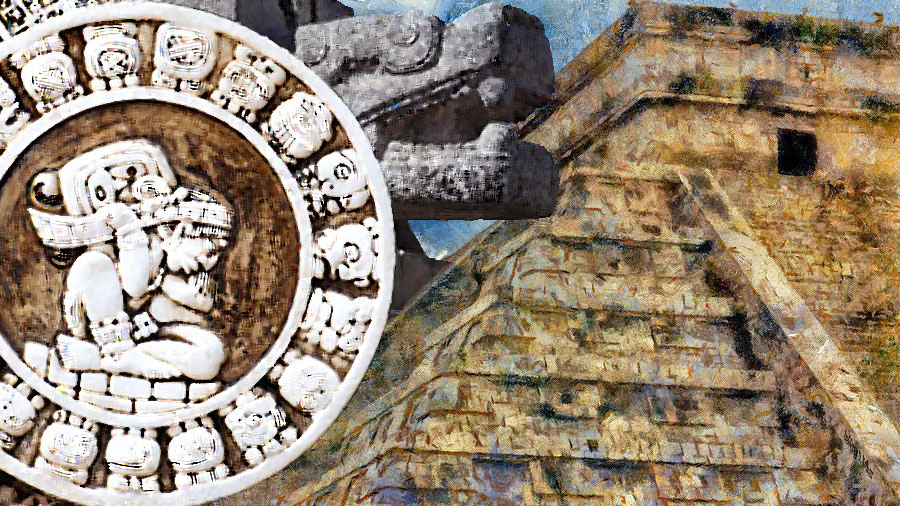Vestiges Of The Mayas
 by Augustus LePlongeon
by Augustus LePlongeon
Yucatan is the peninsula which divides the Gulf of Mexico from the Caribbean Sea. It is comprised between the 17° 30´ and 21° 50´, of latitude north, and the 88° and 91° of longitude west from the Greenwich meridian.
The whole peninsula is of fossiferous limestone formation. Elevated a few feet only above the sea, on the coasts, it gradually raises toward the interior, to a maximum height of above 70 feet. A bird’s-eye view, from a lofty building, impresses the beholder with the idea that he is looking on an immense sea of verdure, having the horizon for boundary; without a hill, not even a hillock, to break the monotony of the landscape. Here and there clusters of palm trees, or artificial mounds, covered with shrubs, loom above the green dead-level as islets, over that expanse of green foliage, affording a momentary relief to the eyes growing tired of so much sameness.
About fifty miles from the northwestern coast begins a low, narrow range of hills, whose highest point is not much above 500 feet. It traverses the peninsula in a direction a little south from east, commencing a few miles north from the ruined city of Uxmal, and terminating some distance from the eastern coast, opposite to the magnificent bay of Ascension.
Lately I have noticed that some veins of red oxide of iron exist among these hills—quarries of marble must also be found there; since the sculptured ornaments that adorn the facade of all the monuments at Uxmal are of that stone. Today the inhabitants of Yucatan are even ignorant of the existence of these minerals in their country, and ocher to paint, and marble slabs to floor their houses, are imported from abroad. I have also discovered veins of good lithographic stones that could be worked at comparatively little expense.
The surface of the country is undulating; its stony waves recall forcibly to the mind the heavy swell of mid-ocean. It seems as if, in times long gone by, the soil was upheaved, en masse, from the bottom of the sea, by volcanic forces. This upheaval must have taken place many centuries ago, since isolated columns of Katuns 1m. 50c. square, erected at least 6,000 years ago, stand yet in the same perpendicular position, as at the time when another stone was added to those already piled up, to indicate a lapse of twenty years in the life of the nation.
It is, indeed, a remarkable fact, that whilst the surrounding countries—Mexico, Guatemala, Cuba and the other West India Islands—are frequently convulsed by earthquakes, the peninsula of Yucatan is entirely free from these awe-inspiring convulsions of mother earth. This immunity may be attributed, in my opinion, to the innumerable and extensive caves with which the whole country is entirely honeycombed; and the large number of immense natural wells, called Senotes, that are to be found everywhere. These caves and senotes afford an outlet for the escape of the gases generated in the superficial strata of the earth. These, finding no resistance to their passage, follow, harmlessly, these vents without producing on the surface any of those terrible commotions that fill the heart of man and beast alike with fright and dismay.
Some of those caves are said to be very extensive—None, however, has been thoroughly explored. I have visited a few, certainly extremely beautiful, adorned as they are with brilliant stalactites depending from their roofs, that seem as if supported by the stalagmites that must have required ages to be formed gradually from the floor into the massive columns, as we see them today.
In all the caves are to be found either inexhaustible springs of clear, pure, cold water, or streams inhabited by shrimps and fishes. No one can tell whence they come or where they go. All currents of water are subterraneous. Not a river is to be found on the surface; not even the smallest of streamlets, where the birds of the air, or the wild beasts of the forests, can allay their thirst during the dry season. The plants, if there are no chinks or crevices in the stony soil through which their roots can penetrate and seek the life-sustaining fluid below, wither and die. It is a curious sight that presented by the roots of the trees, growing on the precipituous brinks of the senotes, in their search for water. They go down and down, even a hundred feet, until they reach the liquid surface, from where they suck up the fluid to aliment the body of the tree. They seem like many cables and ropes stretched all round the sides of the well; and, in fact, serves as such to some of the most daring of the natives, to ascend or descend to enjoy a refreshing bath.
These senotes are immense circular holes, the diameter of which varies from 50 to 500 feet, with perpendicular walls from 50 to 150 feet deep. These holes might be supposed to have served as ducts for the subterranean gases at the time of the upheaval of the country. Now they generally contain water. In some, the current is easily noticeable; many are completely dry; whilst others contain thermal mineral water, emitting at times strong sulphurous odor and vapor.
Many strange stories are told by the aborigines concerning the properties possessed by the water in certain senotes, and the strange phenomena that takes place in others. In one, for example, you are warned to approach the water walking backward, and to breathe very softly, otherwise it becomes turbid and unfit for drinking until it has settled and become clear again. In another you are told not to speak above a whisper, for if any one raises the voice the tranquil surface of the water immediately becomes agitated, and soon assumes the appearance of boiling; even its level raises. These and many other things are told in connection with the caves and senotes; and we find them mentioned in the writings of the chroniclers and historians from the time of the Spanish conquest.
No lakes exist on the surface, at least within the territories occupied by the white men. Some small sheets of water, called aguadas, may be found here and there, and are fed by the underground current; but they are very rare. There are three or four near the ruins of the ancient city of Mayapan: probably its inhabitants found in them an abundant supply of water. Following all the same direction, they are, as some suppose, no doubt with reason, the outbreaks of a subterranean stream that comes also to the surface in the senote of Mucuyché. A mile or so from Uxmal is another aguada; but judging from the great number of artificial reservoirs, built on the terraces and in the courts of all the monuments, it would seem as if the people there depended more on the clouds for their provision of water than on the wells and senotes. Yet I feel confident that one of these must exist under the building known as the Governor’s house; having discovered in its immediate vicinity the entrance—now closed—of a cave from which a cool current of air is continually issuing; at times with great force.
I have been assured by Indians from the village of Chemax, who pretend to know that part of the country well, that, at a distance of about fifty miles from the city of Valladolid, the actual largest settlement on the eastern frontier, in the territories occupied by the Santa Cruz Indians, there exists, near the ruins of Kaba, two extensive sheets of water, from where, in years gone by, the inhabitants of Valladolid procured abundant supply of excellent fishes. These ruins of Kaba, said to be very interesting, have never been visited by any foreigner; nor are they likely to be for many years to come, on account of the imminent danger of falling into the hands of those of Santa Cruz—that, since 1847, wage war to the knife against the Yucatecans.
On the coast, the sea penetrating in the lowlands have formed sloughs and lakes, on the shores of which thickets of mangroves grow, with tropical luxuriancy. Intermingling their crooked roots, they form such a barrier as to make landing well nigh impossible. These small lakes, subject to the ebb and flow of the tides, are the resort of innumerable sea birds and water fowls of all sizes and descriptions; from the snipe to the crane, and brightly colored flamingos, from the screeching sea gulls to the serious looking pelican. They are attracted to these lakes by the solitude of the forests of mangroves that afford them excellent shelter, where to build their nests, and find protection from the storms that, at certain season of the year, sweep with untold violence along the coast: and because with ease they can procure an abundant supply of food, these waters being inhabited by myriads of fishes, as they come to bask on the surface which is seldom ruffled even when the tempest rages outside.
Notwithstanding the want of superficial water, the air is always charged with moisture; the consequence being a most equable temperature all the year round, and an extreme luxuriance of all vegetation. The climate is mild and comparatively healthy for a country situated within the tropics, and bathed by the waters of the Mexican Gulf. This mildness and healthiness may be attributed to the sea breezes that constantly pass over the peninsula, carrying the malaria and noxious gases that have not been absorbed by the forests, which cover the main portion of the land; and to the great abundance of oxygen exuded by the plants in return. This excessive moisture and the decomposition of dead vegetable matter is the cause of the intermittent fevers that prevail in all parts of the peninsula, where the yellow fever, under a mild form generally, is also endemic. When it appears, as this year, in an epidemic form, the natives themselves enjoy no immunity from its ravages, and fall victims to it as well as unacclimated foreigners.
These epidemics, those of smallpox and other diseases that at times make their appearance in Yucatan, generally present themselves after the rainy season, particularly if the rains have been excessive. The country being extremely flat, the drainage is necessarily very bad: and in places like Merida, for example, where a crowding of population exists, and the cleanliness of the streets is utterly disregarded by the proper authorities, the decomposition of vegetable and animal matter is very large; and the miasmas generated, being carried with the vapors arising from the constant evaporation of stagnant waters, are the origin of those scourges that decimate the inhabitants. Yucatan, isolated as it is, its small territory nearly surrounded by water, ought to be, if the laws of health were properly enforced, one of the most healthy countries on the earth; where, as in the Island of Cozumel, people should only die of old age or accident. The thermometer varies but little, averaging about 80° Far. True, it rises in the months of July and August as high as 96° in the shade, but it seldom falls below 65° in the month of December. In the dry season, from January to June, the trees become divested of their leaves, that fall more particularly in March and April. Then the sun, returning from the south on its way to the north, passes over the land and darts its scorching perpendicular rays on it, causing every living creature to thirst for a drop of cool water; the heat being increased by the burning of those parts of the forests that have been cut down to prepare fields for cultivation.
In the portion of the peninsula, about one-third of it, that still remains in possession of the white, the Santa Cruz Indians holding, since 1847, the richest and most fertile, two-thirds, the soil is entirely stony. The arable loam, a few inches in thickness, is the result of the detriti of the stones, mixed with the remainder of the decomposition of vegetable matter. In certain districts, towards the eastern and southern parts of the State, patches of red clay form excellent ground for the cultivation of the sugar cane and Yuca root. From this an excellent starch is obtained in large quantities. Withal, the soil is of astonishing fertility, and trees, even, are met with of large size, whose roots run on the surface of the bare stone, penetrating the chinks and crevices only in search of moisture. Often times I have seen them growing from the center of slabs, the seed having fallen in a hole that happened to be bored in them. In the month of May the whole country seems parched and dry. Not a leaf, not a bud. The branches and boughs are naked, and covered with a thick coating of gray dust. Nothing to intercept the sight in the thicket but the bare trunks and branches, with the withes entwining them. With the first days of June come the first refreshing showers. As if a magic wand had been waved over the land, the view changes—life springs everywhere. In the short space of a few days the forests have resumed their holiday attire; buds appear and the leaves shoot; the flowers bloom sending forth their fragrance, that wafted by the breeze perfume the air far and near. The birds sing their best songs of joy; the insects chirp their shrillest notes; butterflies of gorgeous colors flutter in clouds in every direction in search of the nectar contained in the cups of the newly-opened blossom, and dispute it with the brilliant humming-birds. All creation rejoices because a few tears of mother Nature have brought joy and happiness to all living beings, from the smallest blade of grass to the majestic palm; from the creeping worm to man, who proudly titles himself the lord of creation.
Yucatan has no rich metallic mines, but its wealth of vegetable productions is immense. Large forests of mahogany, cedar, zapotillo trees cover vast extents of land in the eastern and southern portions of the peninsula; whilst patches of logwood and mora, many miles in length, grow near the coast. The wood is today cut down and exported by the Indians of Santa Cruz through their agents at Belize. Coffee, vanilla, tobacco, india-rubber, rosins of various kinds, copal in particular, all of good quality, abound in the country, but are not cultivated on account of its unsettled state; the Indians retaining possession of the most fertile territories where these rich products are found.
The whites have been reduced to the culture of the Hennequen plant (agave sisalensis) in order to subsist. It is the only article of commerce that grows well on the stony soil to which they are now confined. The filament obtained from the plant, and the objects manufactured from it constitute the principal article of export; in fact the only source of wealth of the Yucatecans. As the filament is now much in demand for the fabrication of cordage in the United States and Europe, many of the landowners have ceased to plant maize, although the staple article of food in all classes, to convert their land into hennequen fields. The plant thrives well on stony soil, requires no water and but little care. The natural consequence of planting the whole country with hennequen has been so great a deficiency in the maize crop, that this year not enough was grown for the consumption, and people in the northeastern district were beginning to suffer from the want of it, when some merchants of Merida imported large quantities from New York. They, of course, sold it at advanced prices, much to the detriment of the poorer classes. Some sugar is also cultivated in the southern and eastern districts, but not in sufficient quantities even for the consumption; and not a little is imported from Habana.
The population of the country, about 250,000 souls all told, are mostly Indians and mixed blood. In fact, very few families can be found of pure Caucasian race. Notwithstanding the great admixture of different races, a careful observer can readily distinguish yet four prominent ones, very noticeable by their features, their stature, the conformation of their body. The dwarfish race is certainly easily distinguishable from the descendants of the giants that tradition says once upon a time existed in the country, whose bones are yet found, and whose portraits are painted on the walls of Chaacmol’s funeral chamber at Chichen-Itza. The almond-eyed, flat-nosed Siamese race of Copan is not to be mistaken for the long, big-nosed, flat-headed remnant of the Nahualt from Palenque, who are said to have invaded the country some time at the beginning of the Christian era; and whose advent among the Mayas, whose civilization they appear to have destroyed, has been commemorated by calling the west, the region whence they came, according to Landa, Cogolludo and other historians, NOHNIAL, a word which means literally big noses for our daughters; whilst the coming of the bearded men from the east, better looking than those of the west, if we are to give credit to the bas-relief where their portraits are to be seen, was called CENIAL—ornaments for our daughters.
If we are to judge by the great number of ruined cities scattered everywhere through the forests of the peninsula; by the architectural beauty of the monuments still extant, the specimens of their artistic attainments in drawing and sculpture which have reached us in the bas-reliefs, statues and mural paintings of Uxmal and Chichen-Itza; by their knowledge in mathematical and astronomical sciences, as manifested in the construction of the gnomon found by me in the ruins of Mayapan; by the complexity of the grammatical form and syntaxis of their language, still spoken today by the majority of the inhabitants of Yucatan; by their mode of expressing their thoughts on paper, made from the bark of certain trees, with alphabetical and phonetical characters, we must of necessity believe that, at some time or other, the country was not only densely populated, but that the inhabitants had reached a high degree of civilization. Today we can conceive of very few of their attainments by the scanty remains of their handiwork, as they have come to us injured by the hand of time, and, more so yet, by that of man, during the wars, the invasions, the social and religious convulsions which have taken place among these people, as among all other nations. Only the opening of the buildings which contain the libraries of their learned men, and the reading of their works, could solve the mystery, and cause us to know how much they had advanced in the discovery and explanation of Nature’s arcana; how much they knew of mankind’s past history, and of the nations with which they held intercourse. Let us hope that the day may yet come when the Mexican government will grant to me the requisite permission, in order that I may bring forth, from the edifices where they are hidden, the precious volumes, without opposition from the owners of the property where the monuments exist. Until then we must content ourselves with the study of the inscriptions carved on the walls, and becoming acquainted with the history of their builders, and continue to conjecture what knowledge they possessed in order to be able to rear such enduring structures, besides the art of designing the plans and ornaments, and the manner of carving them on stone.
Let us place ourselves in the position of the archæologists of thousands of years to come, examining the ruins of our great cities, finding still on foot some of the stronger built palaces and public buildings, with some rare specimens of the arts, sciences, industry of our days, the minor edifices having disappeared, gnawed by the steely tooth of time, together with the many products of our industry, the machines of all kinds, creation of man’s ingenuity, and his powerful helpmates. What would they know of the attainments and the progress in mechanics of our days? Would they be able to form a complete idea of our civilization, and of the knowledge of our scientific men, without the help of the volumes contained in our public libraries, and maybe of some one able to interpret them? Well, it seems to me that we stand in exactly the same position concerning the civilization of those who have preceded us five or ten thousand years ago on this continent, as these future archæologists may stand regarding our civilization five or ten thousand years hence.
It is a fact, recorded by all historians of the Conquest, that when for the first time in 1517 the Spaniards came in sight of the lands called by them Yucatan, they were surprised to see on the coast many monuments well built of stone; and to find the country strewn with large cities and beautiful monuments that recalled to their memory the best of Spain. They were no less astonished to meet in the inhabitants, not naked savages, but a civilized people, possessed of polite and pleasant manners, dressed in white cotton habiliments, navigating large boats propelled by sails, traveling on well constructed roads and causeways that, in point of beauty and solidity, could compare advantageously with similar Roman structures in Spain, Italy, England or France.
I will not describe here the majestic monuments raised by the Mayas. Mrs. Le Plongeon, in her letters to the New York World, has given of those of Uxmal, Ake and Mayapan, the only correct description ever published. My object at present is to relate some of the curious facts revealed to us by their weather-beaten and crumbling walls, and show how erroneous is the opinion of some European scientists, who think it not worth while to give a moment of their precious time to the study of American archæology, because say they: No relations have ever been found to have existed between the monuments and civilizations of the inhabitants of this continent and those of the old world. On what ground they hazard such an opinion it is difficult to surmise, since to my knowledge the ancient ruined cities of Yucatan, until lately, have never been thoroughly, much less scientifically, explored. The same is true of the other monumental ruins of the whole of Central America.
When Mrs. Le Plongeon and myself landed at Progresso, in 1873, we thought that because we had read the works of Stephens, Waldeck, Norman, Fredeichstal; carefully examined the few photographic views made by Mr. Charnay of some of the monuments, we knew all about them. Alas! vain presumption! When in presence of the antique shrines and palaces of the Mayas, we soon saw how mistaken we had been; how little those writers had seen of the monuments they had pretended to describe: that the work of studying them systematically was not even begun; and that many years of close observation and patient labor would be necessary in order to dispel the mysteries which hang over them, and to discover the hidden meaning of their ornaments and inscriptions. To this difficult task we resolved to dedicate our time, and to concentrate our efforts to find a solution, if possible, to the enigma.
To continue reading see full pdf download here.
Posted in Other Topics, True History of Manwith comments disabled.





